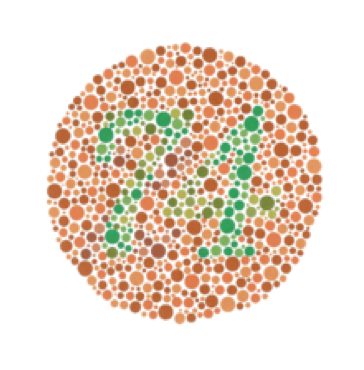LIGHT, EYE AND VISION
Visible light is a kind of electromagnetic radiation, it is a narrow part of the electromagnetic spectrum that is visible to the human eye. Light, like other types of electromagnetic radiation, exhibits characteristics of both waves and particles - this is referred to as the dual nature of light. Light sometimes acts like particles, e.g. when comes into contact with matter. At the same time light acts like electromagnetic waves - it undergoes diffraction and interference just like a wave. Light propagation is affected by the phenomena like refraction, reflection, diffraction and interference. As an electromagnetic wave, light has both electric and magnetic field components, which oscillate in a fixed relationship to one another, perpendicular to each other and perpendicular to the direction of wave propagation. The electromagnetic wave can be characterized by its frequency and wavelength.
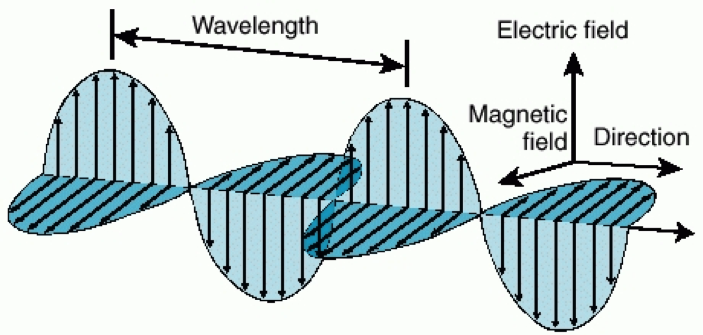
Photon as the particle of light has no charge and always is moving at the speed of light (has zero mass and rest energy). Its energy is related to the frequency of the electromagnetic wave by the formula E = h∙f therefore, a photon can be assumed as a discrete quantum of energy. Photons can be destroyed (or created) when radiation is absorbed or emitted.
Frequency, wavelength, energy and colour[edit | edit source]
The frequency, wavelength and energy of photons are elementary parameters of the wave and they are related to each other. A typical human eye will respond to wavelengths from 390 to 700 nm (in vacuum or air). In terms of frequency this corresponds to a band in the vicinity of 430–790 THz. The energy (E) carried by a photon is given by the frequency: E = h . f, where h is the Planck constant. The unit used for quantification of the amount of energy is typically electron volt (eV), a unit of energy equal to approximately 1.6×10−19 J.
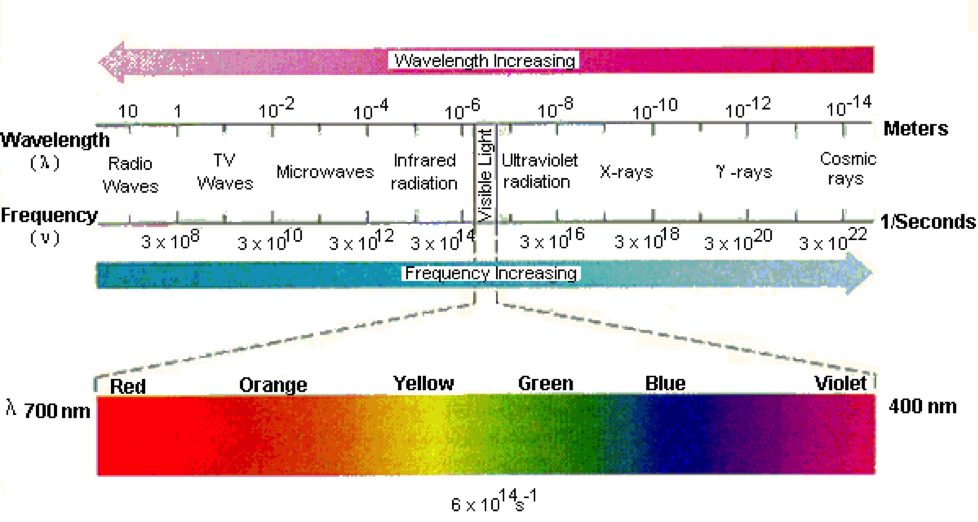
Our perception of colour is based on perception of the light wavelength (or combination of light wavelengths). A light-adapted eye generally has its maximum sensitivity at around 555 nm (540 THz), in the green region of the optical spectrum. The spectrum does not contain all the colours that the human eye and brain can distinguish. Unsaturated colours such as variations of pink or purple are absent because they can only be made by a mix of multiple wavelengths. Colours containing only one wavelength are called pure colours.
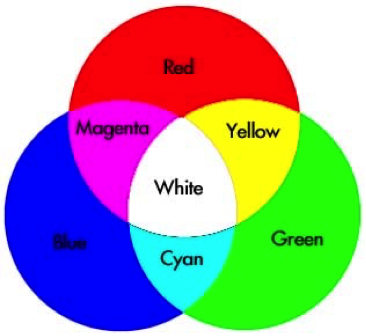
Photometry and brightness[edit | edit source]
Brightness is an attribute of visual perception, which appears when a source radiates or reflects light. In other words, brightness is the perception elicited by the luminance of a visual target. This is a subjective attribute/property of an object being observed.
The human eye is not equally sensitive to all wavelengths of visible light. The standardized model of the eyes response to light as a function of wavelength is given by the luminosity function. Note that the eye has different responses as a function of wavelength when it is adapted to light conditions (photopic vision) and dark conditions (scotopic vision).
The luminosity describes the average spectral sensitivity of human visual perception of brightness. It is based on a subjective judgement, in which a pair of different coloured lights are brighter to describe relative sensitivity to light of different wavelengths. It should not be considered perfectly accurate in every case, but it is a very good representation of visual sensitivity of the human eye and it is valuable as a baseline for experimental purposes.
Ultraviolet and infrared light[edit | edit source]
Ultraviolet (UV) light is electromagnetic radiation with a wavelength shorter than visible light, but longer than X-rays. It is in the range between 400- 100 nm, corresponding to photon energies from 3 eV to 124 eV. It is named ultraviolet because the spectrum consists of electromagnetic waves with frequencies higher than those humans identify as the color violet. These frequencies are invisible to humans, but wavelengths near UV are visible to several insects and birds.
Of the ultraviolet radiation that reaches the Earth's surface up to 95% is UVA. Ordinary window glass passes about 90% of the light above 350 nm, but blocks over 90% of the light below 300 nm.
The shorter bands of UVC, as well as more energetic radiation produced by the Sun, generate the ozone in the ozone layer when single oxygen atoms produced by UV photolysis of dioxygen react with more dioxygen. The ozone layer is important for blocking UVB and part of UVC. Although the shortest wavelengths of UVC (and those even shorter) are blocked by ordinary air.
Infrared (IR) light is electromagnetic radiation with longer wavelengths than those of visible light, extending from the nominal red edge of the visible spectrum at 700 nanometres (nm) to 1 mm. This range of wavelengths corresponds to a frequency range of approximately 430 THz down to 300 GHz. Most of the thermal radiation emitted by objects near room temperature is infrared.
Infrared radiation can be used to remotely determine the temperature of objects (if the emissivity is known). This is termed thermography. Thermographic cameras detect radiation in the infrared range of the electromagnetic spectrum (roughly 900–14,000 nanometers or 0.9–14 μm) and produce images of that radiation. Infrared radiation is emitted by all objects, based on their temperature. The black body radiation law states that; thermography makes it possible to "see" ones environment with or without visible illumination. The amount of radiation emitted by an object increases with temperature, therefore thermography allows us to see variations in temperature.
Eye[edit | edit source]
Eye is the organ of vision - it converts light into electrical signals transmitted by neurons. The shape of the eye is a slightly asymmetrical globe, whose diameter is about 25mm. The visible front part of the eye consists of iris, cornea, pupil, sclera (the white part) and conjunctiva (a clear layer of tissue covering the front of the eye, except the cornea).
The cornea is the front part of the eye. It is a transparent layer (does not have blood vessels) with a thickness of about 0.6 mm. Cornea represents the strongest part of the refracting power of the eye. It provides about 70% of the power of the eyes optical system. The refractive power of the cornea is about 40 dioptres. The index of refraction of the cornea is about 1.376 and most of the refraction is at the cornea-air interface. Due to a constant refractive power its focus is fixed.
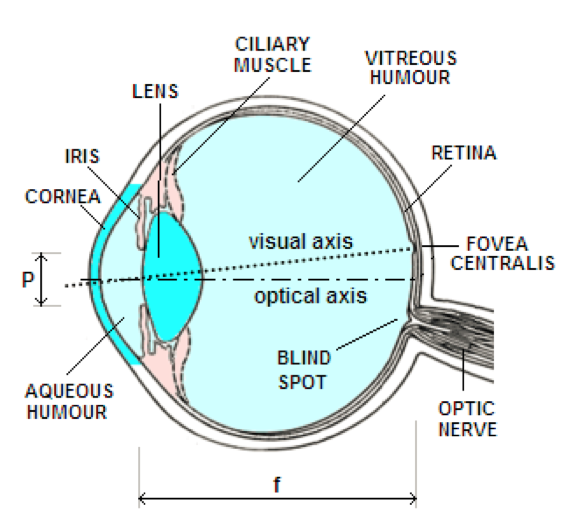
The iris is a thin, circular structure in the eye responsible for controlling the diameter and size of the pupil and the amount of light reaching the retina. The color of the iris is often referred to as "eye color." The iris is a contractile structure, consisting mainly of smooth muscle surrounding the pupil. Light enters the eye through the pupil, and the iris regulates the amount of light by controlling the size of the pupil (similarly to the shutter in camera).
Just behind the iris and pupil lies the lens. The lens focuses light at the back of the eye. About 9mm in diameter and 4 mm thick, the crystalline lens provides perhaps 20% of the refracting power of the eye. The index ranges from about 1.406 at the center to about 1.386 in outer layers making it a gradient index lens. It is pliable, and changes shape for close focusing. This is known as accommodation.
Most of the eye is filled with a clear gel called the vitreous. Light projects through the pupil and the lens to the back of the eye. The inside lining of the eye is covered by special light-sensing cells that are collectively called the retina. The retina covers about 65 percent of the eyes interior surface. Photosensitive cells called rods and cones in the retina convert light energy into electrical signals, that are carried to the brain by the optic nerve. In the middle of the retina is a small dimple called the fovea or fovea centralis. This is the center of the eyes sharpest vision and the location of most color perception.
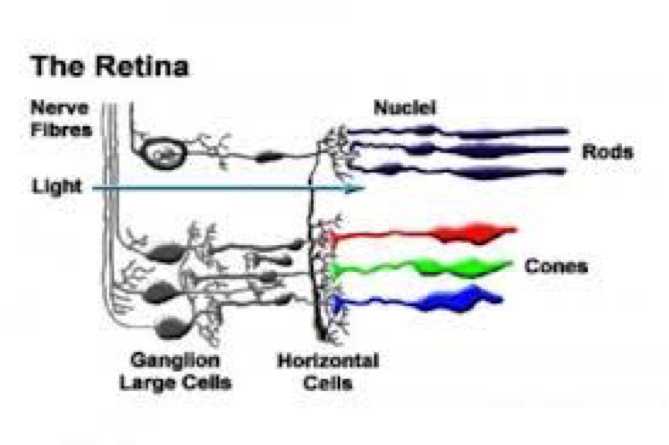
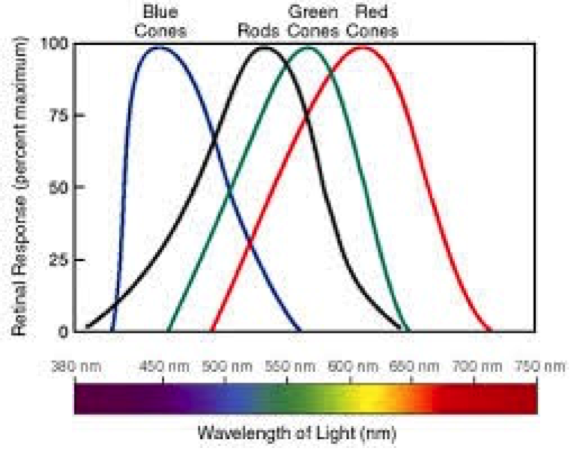
The optic nerve is a bundle of nerve fibers that carries the electrical signal from the retina to the brain for processing. The point where the optic nerve exits through the retina does not have any rods or cones, and thus produces a "blind spot".
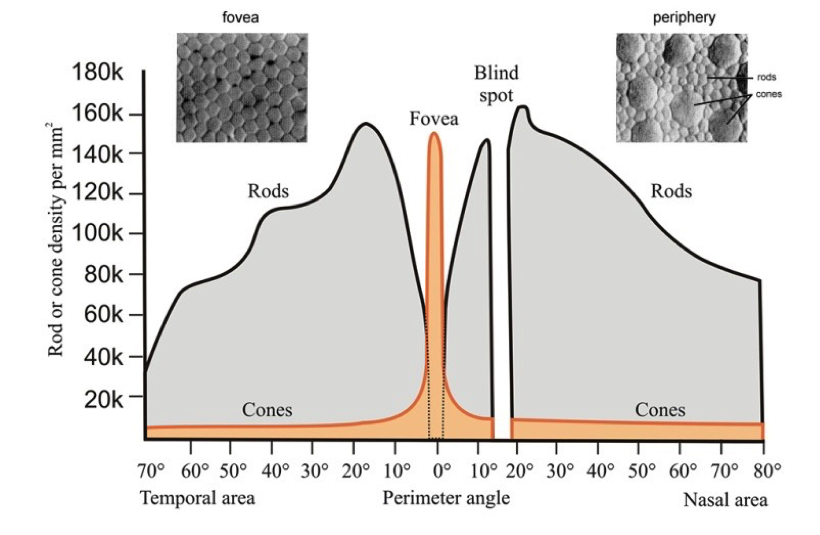
Though
the eye receives data from a field of about 200 degrees, the acuity over most
of that range is poor. To form high resolution images, the light must fall on
the fovea, and that limits the acute vision angle to about 15 degrees. In low
light, this fovea constitutes a second blind spot since it is exclusively cones
which have low light sensitivity. At night, to get most acute vision one must
shift the vision slightly to one side, say 4 to 12 degrees so that the light
falls on some rods.
Vision defects[edit | edit source]
Common eye defects like myopia (nearsightedness), hyperopia (farsightedness) and astigmatism are often called "refractive errors". They affect how the eyes bend or "refract" light and they can usually be corrected by relatively simple compensating lenses or by surgery changing the shape of the cornea in order to improve the refractive state of the eye. Reshaping of the cornea is frequently performed by photoablation using laser.
Myopia (Nearsightedness)
Myopia, or nearsightedness, is a vision condition in which close objects are seen clearly, but objects farther away appear blurred. Nearsightedness occurs if the eyeball is too long (axial myopia) or the cornea has too much curvature (refractive myopia). As a result, the light entering the eye is not focused correctly and distant objects look blurred.
Nearsightedness is a very common vision condition affecting nearly 30 percent of the US and EU population. Some research supports the theory that nearsightedness is hereditary. There is also growing evidence that it is influenced by the visual stress of too much close work.
[[|framed|center|http://www.wikilectures.eu/index.php/File:4.2.5lightineye.png]]
Generally, nearsightedness first occurs in school-age children. Because the eye continues to grow during childhood, it typically progresses until about the age of 20. However, nearsightedness may also develop in adults due to visual stress or health conditions such as diabetes.
An optometrist can prescribe diverging eyeglasses or contact lenses. This will correct the nearsightedness by bending the visual images that enter the eyes and by focusing the images correctly at the back of the eye. Depending on the severity of nearsightedness, the subject may only need to wear glasses or contact lenses for certain activities, such as watching a movie or driving a car. If the person is severely nearsighted, lenses and glasses may need to be worn all the time. Laser procedures are also a possible treatment for nearsightedness in adults. They involve reshaping the cornea by removing a small amount of eye tissue. This is accomplished by using a highly focused laser beam on the surface of the eye.
Hyperopia (Farsightedness)
Farsightedness or hyperopia, is a vision condition in which distant objects are seen clearly, but close objects does not come into proper focus. Farsightedness occurs if the eyeball is too short or the cornea has too little curvature. Light entering the eye is therefore not focused correctly. Common signs of farsightedness include difficulty in concentrating and maintaining a clear focus on near objects. Also eye strain, fatigue and/or headaches after close work. Aching or burning of the eyes and irritability or nervousness after sustained concentration can also occur.
In case of farsightedness, vision can be corrected by converging eyeglasses or contact lenses - to optically correct farsightedness by altering the way the light enters eyes. Laser procedure is also a possible treatment similar to that of nearsightedness.
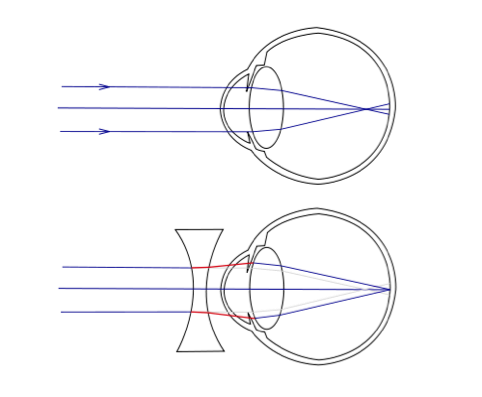
Presbyopia is a vision condition in which the crystalline lens of your eye loses its flexibility. This makes it difficult for you to focus on close objects. Presbyopia may seem to occur suddenly, but the actual loss of flexibility takes place over a number of years. It usually becomes noticeable in the early to mid-40s and is a natural part of the aging process of the eye. It is not a disease, and cannot be prevented. Some signs of presbyopia include the tendency to hold reading materials at arm's length, blurred vision at normal reading distance and eye fatigue, along with headaches when doing close work. A comprehensive optometric examination will include testing for presbyopia.
Astigmatism[edit | edit source]
Astigmatism is a vision condition that causes blurred vision due to the irregular shape of the cornea or the curvature of the lens inside the eye. An irregular shaped cornea or lens prevents light from focusing properly on the retina. As a result, vision becomes blurred at any distance.
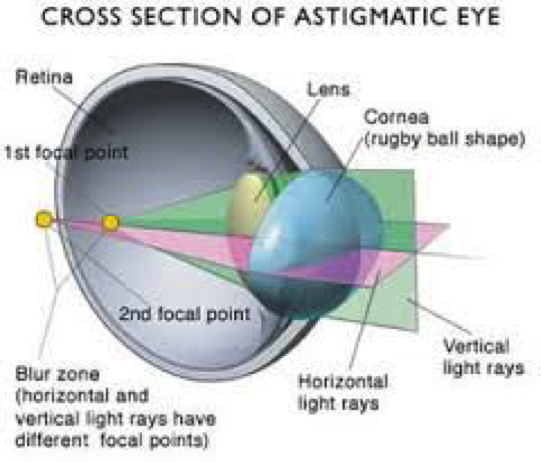
Astigmatism is a very common vision condition and most people have some degree of it. Slight amounts of astigmatism usually don't affect vision and don't require treatment. However, larger amounts causes distorted or blurred vision, eye discomfort and headaches.
Astigmatism frequently occurs with other vision conditions like near-sightedness (myopia) and farsightedness (hyperopia). Compensation for astigmatism can be made by eyeglasses with cylindrical lens (i.e. a lens that has different radii of curvature in different planes), contact lenses or refractive surgery.
Cataract[edit | edit source]
Cataract is a condition that occurs when the inner lens of the eye becomes darkened or opaque. The lens may be surgically replaced with a plastic lens. This can have dramatic results in restoring vision to the eye. The implanted lens is of fixed focal length, meaning it is not capable of accommodation like the natural lens. This is usually not a major concern, because persons that develop cataracts after the age of 60 do not have much accommodation remaining anyways. This is due to the inner lens turning less pliable with age.
Glaucoma[edit | edit source]
Glaucoma is a disease which damage the eyes optic nerve and can result in vision loss and blindness. People with glaucoma will slowly lose their peripheral (side) vision. If glaucoma remains untreated, people may not notice objects to the side and out of the corner of their eye. They seem to be looking through a tunnel. Over time, straight-ahead (central) vision may decrease until no vision remains. The vision lost from the disease cannot be restored.
Colour-blindness[edit | edit source]
Colour blindness is the inability to see colour, or the decreased ability to perceive colour differences under normal lighting conditions. Colour blindness affects a significant percentage of the population. There is no actual blindness but there is a deficiency of colour vision. The most usual cause, is a fault in the development of one or more sets of retinal cones that perceive colour in light and transmit that information to the optic nerve.
Colour blindness can also be produced by physical or chemical damage to the eye, the optic nerve, or parts of the brain.
